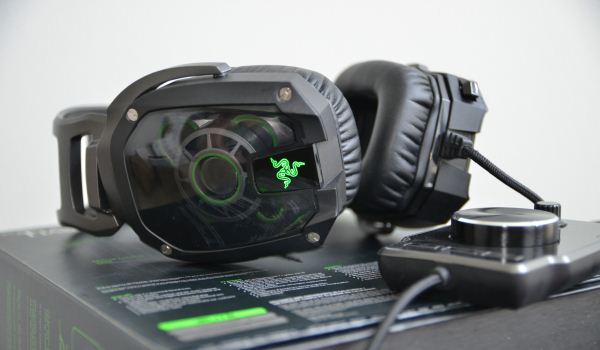Pipeline Review: Razer Tiamat 7.1
by Vivek Gowri on June 15, 2012 4:00 PM EST- Posted in
- Headset
- Peripherals
- Audio
- Razer
What is it?
Razer’s Tiamat 7.1, the first headset to feature 10 discrete drivers for true 7.1 surround sound.
How much?
$179.99 from Razer’s webstore or Amazon.com
What does it do?
The Tiamat is a desktop headset, with very long cables, a large volume control unit (which features a toggle between headphones and an audio system), and a reliance on USB power. It has five 3.5mm jacks, four for different audio channels and one for mic, along with a USB used exclusively for power. Each circumaural cup has five drivers: one for front, rear, and surround, along with a center channel and a subwoofer in each ear. Razer’s other 7.1 headset, the Megalodon, makes do with two drivers and virtual surround, so this is a significant step up on paper. Compared to other large headsets, the Tiamat appears to have smaller drivers overall with a mix of 30mm (front, center) and 20mm (rear, surround) drivers to complement the 40mm subwoofer drivers. For example, the lower-end Tiamat 2.2 has two 40mm drivers for mid/high range frequencies to go with the two 40mm sub drivers, while Corsair goes with two 50mm drivers and virtual surround in its Vengeance 1500 headset.
Is it any good?
The design and aesthetic of the Tiamat is pretty stunning. Razer has traditionally put a lot of effort into the industrial design and packaging of their products, so this comes as no surprise. The external cover of the circumaural cups is translucent, so you can actually see the individual drivers. It’s awesome to see how the smaller mid/high drivers are dwarfed by the sub, and overall, it’s just a cool aesthetic. The Razer logos on each side light up in green when you plug it in, and the headband on top features matching green stitching. The mic is on the left side, and slides out of the way to stay hidden when you don’t need it. They’re pretty large headphones, to say the least, but they wear comfortably, with padded leatherette ear cups and a headband that fits well.
The audio performance depends on your use cases. In gaming situations (assuming the game supports surround), the Tiamat shines. It’s pretty helpful in placing opponents (especially in racing and FPS games), and the overall experience is pretty stellar. This holds true for well sound-engineered action movies, too. Razer has done a good job optimizing the directionality of the speakers, so you really get a sense of the surround effect. Unfortunately, in music-heavy usage, it leaves a bit to be desired, with sound that’s clearly being made by smaller drivers. This is especially noticeable at the high end, where the sound was pretty thin, maybe even a bit tinny. An audiophile would probably be better served by a mid-priced set of cans like the Sony MDR-V6 or something similar.
Razer has always been a company that has prioritized gaming over any other use case, and the Tiamat is certainly no different. But given the pricepoint, I’d like to see a bit more versatility and better audio quality for music.
Should I buy one?
Regardless of my recommendation here, I’m not sure it’s possible to find the Tiamat in stock anywhere. Razer’s store shows 4-8 weeks for delivery, while Amazon quotes 1-3 months. The Tiamat has garned enough interest that even three months after launch, Razer is having trouble manufacturing enough Tiamat units to meet demand. As with many of Razer’s products, the Tiamat is very premium in terms of quality and design and offers some unique and attractive features. It’s seriously pricey though, and if you listen to a lot of music, you’re probably not going to be thrilled with the audio fidelity. But if you’re really into gaming, this is one of the more desirable headset options out there, and that's just how Razer wants it.












14 Comments
View All Comments
Ninhalem - Monday, June 18, 2012 - link
This reminds me of the Tritton AX-720, but way less comfortable. I have worn the Tritton for more than 6 hours of gameplay without it every cramping my ears unlike Razer's design. The sound quality, however, could be significantly better on the Razer than the Tritton (I don't know how many drivers the Tritton uses), but I would rather give up sound quality instead of comfort.rms - Tuesday, July 3, 2012 - link
The biggest problem is buzzing, modulated by mouse movement. Razer blames this on dirty usb power, and suggests an external usb power block, which hasn't helped here. I haven't tried ferrite beads or usb isolator, though it may come to that.Ear cups much too small, and sweaty (sennheiser 595 cups are a full 1/2" larger). I see another poster has gotten velour pads to fit, I might try that.
Heavy, and tethered :) I might have been happier with a usb Mixamp dolby headphone + my sennheisers, but wanted to try 'true' surround, and it does add a subtle depth to the soundscape of games that keeps me using them. They are lousy for music/stereo, and I keep the 595's hooked up to an old x-fi pci card for that and switch between them in control panel. This would be another reason to go the Mixamp route, as presumably surround effects could be easily switched off and you won't be playing musical headsets, as I have to do now.
Murm - Thursday, September 6, 2012 - link
I feel like Razer puts out quality products, I have had the Razer Naga for a very long time and all the buttons work and the mouse pad from Razer hasn't worn off after extended use.I feel like the earcups are very comfy and I thought the weight would be a problem but, the head band on these headphones really take the weight off, the earcups are fine in my opinion and even after extreme extended use they don't hurt (17 hours+) , I don't sweat in these headphones but maybe thats because the AC keeps this room 72 degrees all the time.
Obviously they aren't for listening to music, and you should really get different headphones for listening to music. They aren't pricey when your paying what 400 or 500 for music headphones? Spending 200 isn't that bad when it offers an amazing way to tell where your foes are, I play many FPSs and in sneaky games like SnD for Modern warefare I can tell if theres an enemy behind me or running in the next room or not. I can tell where they are in relation to me easily and without effort.
They are premium headphones for gaming, don't buy razer products expecting them to be good for anything else besides gaming. They are made for gamers and focused on gamers needs.
Althought I have one complaint. The mic looks rediculously gay, and very small compaired to these gigantic headphones. BUT I love that it goes into the headphones, between me breaking mics over and over somehow and my dog chewing them it helps that it goes up into the headphones.
Pips - Monday, January 21, 2013 - link
Anyone wanting to buy a gaming headset has one requirement across the board: A microphone. If it doesn't have a mic, it's not a gaming headset. Otherwise people are most certainly better off buying a Grado, Sennheiser, Sony, etc headphones.I just wanted to comment that I found it odd, that a "high end" gaming headset review suggested a pair of non-gaming headsets as an alternative. Those have no place and don't cross paths. You don't see people over at Head-Fi saying if people are looking for a mic on their $1000 Grado cans, they might be better off looking at a Razer. Ridiculous.